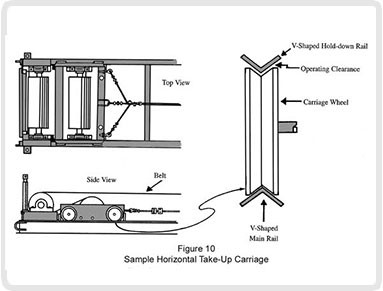Conveyor Belt Sequence of Training Operations
Initial installation of conveyor equipment or the set-up of a radial stacker should ensure good alignment of all pulleys, troughing and return idlers, i.e. they should be placed at right angles to the direction of belt travel, leveled and centered on a straight line. First movement of the belt should be slow and intermittent so that any tendency of the belt to run off may be quickly observed and the belt stopped before damage occurs.
When the conveyor is a long center installation, men should be stationed at frequent intervals to observe the action of the belt. They should be provided with an effective method of communication so as to report their observations and, if necessary, cause the belt to be stopped.
Initial movement of the belt will provide indication of where corrections of the types described are required. The first corrections must be those at points where the belt is in danger of being damaged. Once the belt is clear of all danger points, a sequence of training operations can be followed.
The best procedure to use in starting the training sequence is probably to start with the return run and work toward the tail pulley. This assures early centering of the belt on the tail pulley so that it can be centrally loaded.
If the empty belt troughs readily, so that its running tendencies are not erratic, the training can and should be completed. Should the belt tend toward stiffness and erratic running, getting some load onto the belt as soon as the return run has been straightened up and the belt centered on the tail pulley will help hold the top run.
Normally, the belt can be trained properly onto the tail pulley by manipulation of return idlers and with the assistance of self-aligning return rolls. Seldom is any adjustment of snub or tail pulley necessary but the snub can be used as a supplementary training means.
Training of the top run, with the belt empty, is usually no problem if the belt troughs readily. In this case self-aligners on top are not required except as insurance against damage in the region approaching the head pulley. There, two self-aligners placed approximately 40’ and 80’ preceding the pulley, will help re-center the belt if it is ever forced off due to some temporary disturbance.
It should not be necessary to use the head pulley for training purposes if it has been aligned properly. Likewise, the snub following the head pulley should not be required as a training means. It is relatively ineffective as a training device due to the strong influence of the head pulley.
The take-up carriage has a strong influence on the running of the belt at that point and, due to its movement as belt length changes, is subject to misalignment. A vertical take-up carriage, hanging in a festoon of belt, must be guided in its travel so that the pulley shaft remains horizontal. The belt cannot be depended upon to center itself on the pulley and, once it moves off center, the pulley will tip out of horizontal if not guided closely on its posts.

A horizontal take-up carriage is subject to misalignment due to loose track gauge, fouled rails or even jumping off the track. V-shaped rails will hold the gauge tight and, with the apex upward, are self-cleaning. Hold-down rails above the wheels with sufficient clearance so that they do not touch under normal operation will help prevent jumping off the track. (Figure 10)
With the empty belt trained satisfactorily, good operation with load is usually assured. Disturbances which appear with load are usually due to off-center loading or, to accumulation of material from the load on snub pulleys and return idlers.
When equipment is known to be properly aligned, training action should be taken slowly and in small steps because the belt requires some time to respond to corrective measures. It should begin at some point preceding that where run-off occurs and then gradually proceed forward, in the direction of belt travel, until the run-off condition has been corrected.
Under some conditions of operation where the conveyor is not level, is extremely short or too wide to be affected by permissible crowning, belts with a special guide strip have been used. This V-guide strip runs loosely in grooved pulley and idler rolls. Guide strips are not recommended or necessary for the long conveyors normally encountered in industrial use.
Additional Information
For additional information on this topic and many others, please consult our Radial Stacker / Conveyor Manual. The manual is available in both an interactive browser format, as well as a downloadable and printable PDF version.